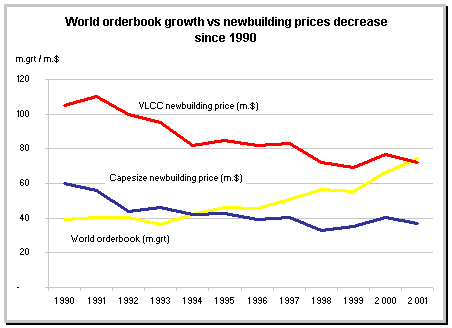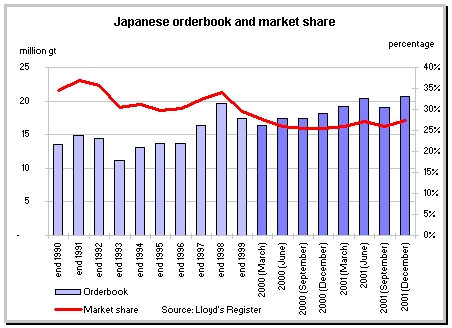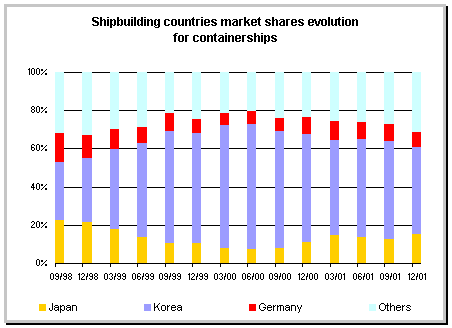
|
|
| The prices |
|
|
The increase in newbuilding prices, which occurred
in 2000 after ten years of decline, has ended.
Prices, however, remained firm in the first
half. But they began to fall during the summer, first of all with bulk
carriers, then with containerships, and finally in the autumn with tankers.

The decline in freight rates is such that some
owners, already obliged to take drastic measures such as putting some
newly delivered ships into lay-up, have decided to undertake with more or
less success, new negotiations with the shipyards, either to postpone
deliveries on recent orders, or even wherever possible to cancel them.

|

|
|
|

Japanese shipbuilders were often able to offer better delivery dates
during the first half of 2001, stealing a march over their Korean rivals
who in 2000 got fully booked up until the beginning of 2004.
They are taking advantage also of the yen's depreciation against
the dollar by some 15 %. Whereas in 2000 the yen fluctuated in a range
between 105 and 110 yen/$, it broke the 120 yen/$ barrier at the start
of the first quarter, to then fluctuate between 120 and 125 yen/$ before
finishing the year above 130 yen/$. Its exchange rate has become
especially attractive compared to the Korean won and the Chinese yuan
which remain closely linked to the dollar.
|
Japanese shipyards which have traditionally favoured the construction
of bulk carriers, where they hold some 60 % share of the market, have
managed to regain a part of the market from their Korean competitors in
the construction of tankers and even containerships.
The market share for tankers has gone up to 27 % end 2001 after
having fallen successively from 38 % end 1998, to 29 % end 1999 and 18 %
in 2000

|
For containerships this share has gone up to
15 % end 2001, having regressed from 22 % end 1998, to 10 % end 1999, and
to 11 % end 2000

|

|

|
Japanese shipbuilders know that they need to continue making efforts to
be more competitive. Their main concern is to prevent a new deterioration
in newbuilding prices. The continuous progress in building capacity,
especially from China, coupled with probable and long-lasting decline in
demand as from 2002, present serious threats.
The President of the Japanese Shipbuilding Association, Toshimichi
Okano, has warned against a competitive drive based on increased volumes.
In order to ensure a better balance between supply and demand, Japan is
proposing to adjust its production by carrying out a regrouping of
newbuilding sites.
NKK and Hitachi have thus announced at the end of the year their
decision to merge their shipbuilding operations. By deciding to close one
of the six docks of this new grouping, which has taken the name of
Universal Shipbuilding, they have started proceedings towards
restructuring and shown the way forward in achieving a better readjustment
of supply and demand. At a time when it is also important to be big enough
to benefit from economies of scale, Universal Shipbuilding becomes after
Mitsubishi Heavy Industries, the second largest shipyard in Japan with
Imabari.
Namura has taken control over Hakodate Dock Shipbuilding.
Sumitomo Heavy Industries and Kawasaki Heavy Industries are studying
the possibility of spinning off in the near future their shipbuilding
activities from their respective groups. This restructuring could take
place in 2002. The regroupings between Kawasaki, Mitsui and IHI are still
under discussion but do not seem to be advancing. Kawasaki and IHI who
signed a co-operation agreement in 1999 have renounced going further for
the moment. It is nonetheless likely that the two companies will spin-off
their shipbuilding activities.
|
 |
North Defiance
16,850 dwt, btl 2001 by Fukuoka Shipbuilding, owned by Tachibanaya and long term chartered to Arrow Tanker USA |
|
The small and medium shipyards could be looking for their part to find
a form of co-operation between themselves or association with some of the
bigger shipyards.
This move towards de-consolidating and downsizing also has its
exceptions. Thus Iwagi Zosen seems to want to leave shiprepairing, and to
concentrate on newbuilding aiming to producing five to six Handymax per
year.
In order to face a doubtless difficult 2002, Japanese builders can also
bet on a further depreciation of the yen against the dollar, whilst Japan
goes through its recession. Nonetheless, on December 27th 2001, the
Chinese daily newspaper - the People's Daily - sounded a warning
shot in writing: "If the yen continues its depreciation trend, this
will force other Asian countries to devalue. Given today's slowdown in
world growth, this could have consequences worse than the 1997-1998 Asian
crisis."
|
 |
Fouesnant
6,902 dwt, blt 2001 by Shin Yong, owned by Socatra |
|
Shipping and Shipbuilding Markets in 2001
I N D E X
|